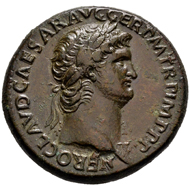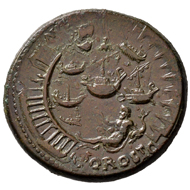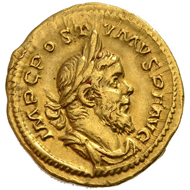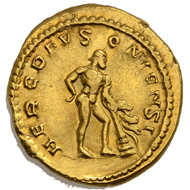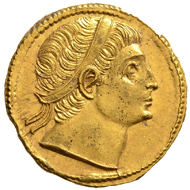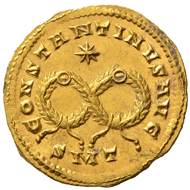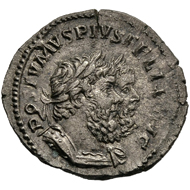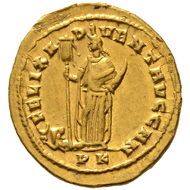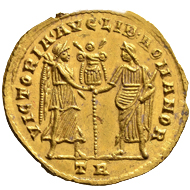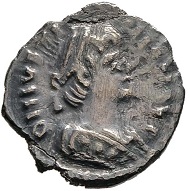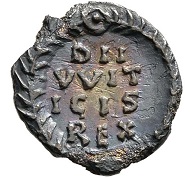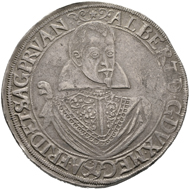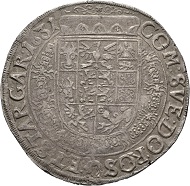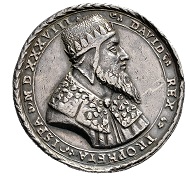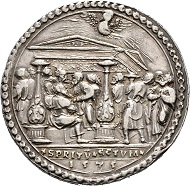01-11-2016 – 03-11-2016
Autumn auction 417 and 418
Peus to offer sought-after Wallenstein double-taler in autumn auction
With its catalogue no. 417 the auction house Dr. Busso Peus Nachfolger from Frankfurt proudly presents, from November 2-4, 2016, the collection of Roman Imperial Coins formed by the Lückger family from Cologne mainly during the 19th and early 20th century.
Nero. Sestertius‚ Rome, 64 (?). Very fine.
The collection was assembled by collectors from four different generations of this family. The most important figure in this line, however, was Herman Joseph Lückger (1864-1951), the owner of a knitwear factory, who was introduced to Numismatics at a rather early age by his grandfather and who would remain an extremely dedicated collector and researcher of Roman coins over all of his life, during which he became the author of several important numismatic publications as well. His main interest was the history and culture of Cologne, his parent city, from the Roman period on.
Postumus in Gallia. Aureus, Cologne 262. Very fine +.
Consequently coins from the third and fourth century AD and from the Gallic Empire are represented within the collection with a large number of rarities and even some unique pieces.
Gordianus III. Antoninianus, Antioch, 238/239. Very fine.
The numerous labels in his clear and exact handwriting, which accompany many of the coins, do not only bear witness to his enormous knowledge and dedication but do also reflect the fascinating history of the European coin trade between the 19th and the 20th centuries.
Constantinus I. Solidus, Ticinum, 326/327. Extremely fine.
The Roman part of the Lückger collection, that is on offer here, may be the most important object of its kind appearing on the German market since the Leo Benz collection.
Postumus in Gallia. Billon off-metal strike from aureus dies, Cologne, 268. 4th known specimen. Extremely fine.
Many entries in RIC quote publications of Lückgers’ coins by himself or by his friend Francesco Gnecchi as their primary source. And special publications on the coinage of the Gallic empire as for example the works of Elmer and of Schulte owe even more to the coins of the Lückger collection.
Maximianus I Herculius. Aureus, Carthage, 297/298. Very fine – extremely fine.
Apart from its scientific importance the collection represents an enormous aesthetic und commercial value: Many of the coins are not only excessively rare but in absolutely outstanding condition as well.
Magnentius. Gold medallion of 1.5 solidi, Treves, 351/353. Unique. Extremely fine.
36 aurei containing an impressive series of multiple portrait coins from the house of Septimius Severus and 34 solidi (with several multipla in the names of Constans, Magnentius and Decentius) underline the extraordinary quality of this historical collection.
Also the other catalogue Peus no. 418 featuring the general sale contains two (though considerably smaller) collections of Roman imperial coins:
Vitiges, 536-541. 1/2 siliqua, in the name of Justinian, Ravenna. very fine / extremely fine.
One of those covers the entire period from the end of the republic to the later Roman Empire; the other, the collection of the late Matthias Römhild from Lohr am Main, is focused on rare imperial issues from the middle to the late 3rd century AD with unusual representations of the imperial bust on the obverse – a small but very appealing collection!
Friedland, Duchy. Albrecht Wenzel Eusebius von Waldstein (Wallenstein), 1627 Duke of Mecklenburg and Duke of Sagan. Double-taler, Jicin, 1631. Dav. – (cf. 3453, there 1632); Meyer-; Poley -. 2nd known specimen. very fine.
In addition there is the usual large offer of coins and medals in gold and silver from medieval to modern times. The broad range of interesting issues features among many other things a double-taler 1631 of Albrecht von Wallenstein from the mint at Jicin (Poley –; our file cabinet mentions only one single appearance in trade from the stock-list 110 of Zschiesche & Köder for 1800.- Goldmark), an excellent 10 ducat piece 1657 from Siebenbürgen, a rectangular triple ducat 1513 of Salzburg and a taler from the bishopric Werden and Helmstedt in excellent condition.
King David. Silver medal 1535/1538. Die by Wolf Milicz. Bust of King David r. / The Outpouring of the Holy Spirit. Very fine original strike.
Moreover there is an important series of rare smaller denominations from the duchy of Sachsen-Hildburghausen, a group of box-talers and -medals and an interesting series of Jewish historical medals.
As always attractive multiple lots at low estimates conclude the sale.
Here you can browse through auction catalogue 417.
You can find the auction catalogue 418 here.
For further details on this and the forthcoming auctions please got to the website of Busso Peus Nachfolger.




